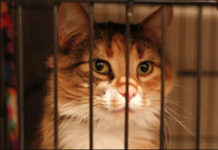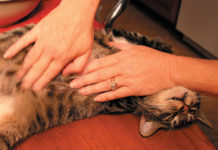Short Takes: April 2011
Researchers studied the effect of distance and neighborhood-level demographics on the number of pet adoptions from an animal shelter ("Use of geospatial neighborhood control locations for epidemiological analysis of community-level pet adoption patterns," American Journal of Veterinary Research, 2010). The methods used to perform the study included client segmentation, geospatial tools, and epidemiological techniques that evaluated locations of 1,563 adoptions from an animal shelter in eastern Massachusetts.
The Female Cat in Heat
The yowls of a cat in heat are unmistakable. When a female cat needs to mate, you should expect incessant crying, strange posturing and constant attempts to escape outdoors to waiting males. The best thing you can do about your cat in heat is to prevent it from happening in the first place. Its a smart idea to have her neutered before her first heat cycle. However, sometimes thats not possible. So if youve never witnessed a cat in heat, heres what you should expect.
Microchips to the Rescue
A study published in the Journal of American Veterinary Medical Association ("Characterization of animals with microchips entering animal shelters," July 2009) determined that 7,704 microchipped animals entered 53 animal shelters between August 2007 and March 2008. Of this number, strays made up more than half (53 percent), with the remainder considered as owner-relinquished animals (41.9 percent) and other (5.1 percent). The results showed that animal shelters were able to find the owners of three-fourths of stray dogs and cats with microchips. The sucess in finding owners was higher in dogs, animals that were purebred and animals that were spayed or neutered. Animal shelters had a much higher likelihood of finding an owner when the owner information was in the shelters own database or registered with a microchip registry. The results emphasize the importance of the registration process in successfully reuniting pets and owners.
The Long Arm of the Law
We live in a litigious society. We have laws governing birth, death and the taxes in between, so its no surprise that we also have a host of laws relating to the animals weve taken into our homes. At the federal level, laws generally address issues such as the safety of pet food, the impact of hazardous products on pets, evacuating and transporting pets during emergencies and regulating the use of animals in research. But most of the laws directly affecting our pets are made at the state and local level. These ordinances can differ by city, township and county, and pet owners should contact local officials when getting a new pet or moving to a new place to find out what possible laws pertain.
Short Takes: 07/09
Legislation in California that seeks to mandate spay and neuter surgery for most cats and dogs has been placed on the suspense file pending further review. Senate Bill 250, introduced in February by Sen. Dean Florez, requires that dogs be spayed or neutered unless their owner gets an unaltered dog license. It also requires that roaming cats be spayed and neutered. The Senate Appropriations Committee analysis on SB 250 states that the bill has costs associated with it in the short term. As a result, it was placed on a list with other bills which have a fiscal impact on state and local governments. All bills placed on the suspense file are scheduled to be taken up together at a later date. Staff and lawmakers review all bills that are projected to cost more than $150,000, and then decide which bills will be released to the committee and voted on.
Spaying: Very Important
When your purebred kitten reaches maturity, you may want to breed her, and you may already have a carefully worked-out strategy for doing so. Otherwise, there is no good reason to avoid having the little animal spayed while shes still in the early months of her life - and there are a number of good reasons for doing so. First and foremost among these reasons, says Andrea Looney, DVM, a lecturer in anesthesiology at the Cornell University Hospital for Animals, is that spaying - also called ovariohysterectomy - will help curb rampant feline overpopulation. According to the American Society for the Prevention of Cruelty to Animals, millions of feral and unwanted domestic cats are born each year. They are either abandoned or relegated to frequently overcrowded shelters and a dismal existence that is often relieved only by euthanasia. Moreover, Dr. Looney points out, spaying a female kitten at four to six months of age - when her reproductive organs are nearing maturity - will dramatically reduce her susceptibility to several life-threatening disorders associated with the feline reproductive system. For example, spaying a kitten prior to her first heat - before her breast tissue develops - will virtually eliminate her risk for mammary cancer later in life. Also, since spaying entails the removal of a females uterus, Dr. Looney notes, the procedure rules out the possibility of pyometra, a potentially fatal collection of pus in that reproductive organ. Other conditions that are prevented include vaginal hyperplasia, a gross swelling of the vaginal wall that occurs during the normal heat cycle; uterine torsion, a twisting of the uterus that may occur late in pregnancy; uterine prolapse, the bulging of the uterus into the vagina; and a variety of infections, cysts and cancers of the uterus and ovaries.
Short Takes: 06/08
Despite protests by the Cat Fanciers Association (and the American Kennel Club), Los Angeles has enacted one of the strictest pet-sterilization laws in the country. Unless youre a registered breeder, failure to spay or neuter a cat after four months of age in L.A. can bring a $500 fine or 40 hours of community service. Advocates of the tough new law say they had no choice. Los Angeles animal shelters had to euthanize 8,960 unwanted cats last year.
The Cat in Heat
The yowls of a cat in heat are unmistakable. When a female cat needs to mate, you should expect incessant crying, strange posturing and constant attempts to escape outdoors to waiting males. The best thing you can do about your cat in heat is to prevent it from happening in the first place. Its a smart idea to have her neutered before her first heat cycle. However, sometimes thats not possible. So if youve never experienced a cat going into heat, heres what you should know. The fertile period of your cats reproductive cycle is called estrus, more commonly referred to as "being in heat." Sexual maturity starts when a female (the queen) is quite young - about six months old. In some cases, it can be as young as four months. Early estrus can often catch uninformed human companions by surprise when they find out their kitten is having kittens. "Shorthair cats typically come into heat sooner than longhair cats," says Jane E. Brunt, DVM, of The Cat Hospital at Towson in Baltimore, MD. And indoor cats may come into heat a little later.
Short Takes: 03/08
If statistics help you make difficult decisions, there are plenty of numbers in a Journal of the American Veterinary Medical Association (Vol. 231, No. 1) article, "Determining the optimal age for gonadectomy of dogs and cats." First the researchers compared benefits and risks of the surgeries. For example, spayed female cats incur an immediate 2.6 percent risk of surgical complications, [IMGCAP(1)]as well as a high risk of obesity, and less than a one percent risk of either FLUTD (feline lower urinary tract disease) or diabetes mellitus - all later in life. None of spayings possible outcomes causes what the researchers termed "substantial morbidity." That is, surgical complications from the spaying (called ovariohysterectomy or OHE) are hardly ever life-threatening.
Short Takes: 09/07
Previous studies examined behavioral changes in cats long after their spay/neuter operations. But this one looked for changes in the first day or two: "Behavioral alterations and severity of pain in cats recovering at home following elective ovariohysterectomy or castration." Reported in the Journal of the American Veterinary Medical Association (Vol. 231, No. 2) the study asked owners about things like their cats time spent sleeping, playfulness, aggression, appetite and vocalization. Most behavior changes were attributed to after-effects of the anesthesia, which wore off the first day, but there was one "interesting" development, the researchers said. On day two, when cats might be expected to complain loudly about losing their reproductive rights, most were quieter than usual.
Neutering and Behavior
Cat owners are often concerned about neutering their male or spaying their female cat. One question they sometimes ask is whether the surgery will change their family cats character and behavior. On this, veterinarians are virtually unanimous: Change will be significant, but it is all to the better. In my way of thinking, it should be done for every cat, says James Richards, DVM, director of the Cornell University Feline Health Center and Editor of…
Mammary Cancer
Early neutering and an owners vigilance can minimize the potentially lethal threat.
















